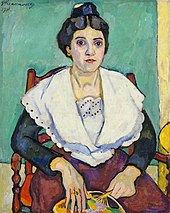Pyotr Konchalovsky
Pyotr Petrovich Konchalovsky ( Russian Пётр Петро́вич Кончало́вский ; born February 21, 1876 in Slovyansk , Russian Empire ; † February 2, 1956 in Moscow ) was a Russian painter, graphic artist and set designer.
Life
Pyotr Konchalovsky grew up as the son of an art book publisher in Ukraine and began his drawing training at the Maria Rajewskaja Ivanova drawing school in Charkow . The family moved to Moscow in 1889, and he attended classes at the Moscow School of Painting, Sculpture, and Architecture during his high school years . In Paris he studied from 1896 to 1898 with Jean-Paul Laurens and Jean-Joseph Benjamin-Constant at the Académie Julian . He then studied with interruptions from 1898 to 1907 at the Art Academy in Saint Petersburg . Among his teachers there were Sawinski, Hugo Salemannand Pawel Kowalewski. In 1902 he made a trip to Italy, again in 1904 and was several times in France (1907-08, 1910, 1913), in France and Spain (1912) and together with Vasili Surikow in 1914 in Germany and Italy. After the First World War he was able to travel again to Italy and France in 1924/25.
Since 1908 he has participated in various exhibitions and groups of artists: "Golden Fleece", "Brotherhood", World of Art (1911, 1912, 1915-22) and "New Society of Artists". In France he exhibited in the Salon d'Automne (1908, 1910) and Salon des Indépendants (1908, 1910-12). In 1911 he was one of the founders of the artist group Karo-Bube and was its chairman in 1911, but left again in 1916. Dawid Burljok , co-founder of the diamond boy, counted Konchalovsky among the “savages” of Russia in 1913 in his contribution to the almanac Der Blaue Reiter . Together with Robert Genin , Alexej Jawlensky , Wassily Kandinsky and Marianne von Werefkin , he took part in the Baltic Exhibition in Malmö in 1914 . He was organized with the "Moscow Painters", in the group "Existence" (1926-27) and in the "Society of Moscow Artists", as well as in the "Association of Artists of Revolutionary Russia" (1926).
From 1918 he worked as an art teacher at independent art schools and was active as a teacher at Wchutemas and Wchutein from 1926 to 1929 . As a set designer , he had orders from various stages since 1905: the Simin Opera (1905, 1912), the Bolshoi Theater (1920-21, 1932, 1944-45) and the Stanislavski-Nemirowitsch-Danchenko Theater (1921, 1932). In 1932 he acquired from the artist Anna Ivanovna Trojanowskaja the farm Bugry on the edge of the later Obninsks .
In 1922 he had his first fifteen solo exhibitions from 1951 in the Tretyakov Gallery with 165 works. In 1922 he took part in the First Russian Art Exhibition in Berlin . It was also shown abroad in the Exhibition of Russian Art in New York (1924) and in the Exposition internationale des Arts Décoratifs et industriels moderne in Paris (1925). In the Soviet Union he made major trips to the Crimea , Novgorod and Pskov (1925, 1926, 1928), the Caucasus (1927, 1935) and Murmansk and Arkhangelsk (1936).
In later years he painted in the style of the officially required Socialist Realism . Konchalovsky was honored as a People's Artist of the RSFSR in 1946, and in 1942 he was also awarded the Stalin Prize . In 1947 he became a member of the Academy of Arts of the USSR .
Konchalowski had been married to Olga, the eldest daughter of the painter Vasily Surikov , since 1902 ; they had a daughter Natalia (1903) and a son Mikhail (1906). Among their descendants are a number of artists, his son-in-law was the Soviet poet Sergei Vladimirovich Mikhalkov . Konchalovsky is buried in the Novodevichy Cemetery.
literature
- Art Association for the Rhineland and Westphalia and Städtische Kunsthalle Düsseldorf : Russian and Soviet art. Tradition - Present USSR. Works from six centuries . December 7, 1984 to January 27, 1985.
- P. Ettinger : Konchalovsky, Pyotr Petrovich . In: Hans Vollmer (Hrsg.): General lexicon of fine artists from antiquity to the present . Founded by Ulrich Thieme and Felix Becker . tape 21 : Knip – Kruger . EA Seemann, Leipzig 1927, p. 284-285 .
- Konchalovsky, Pyotr Petrovich . In: Hans Vollmer (Hrsg.): General Lexicon of Fine Artists of the XX. Century. tape 3 : K-P . EA Seemann, Leipzig 1956, p. 95-96 .
Web links
- Literature by and about Pyotr Petrovich Konchalovsky in the catalog of the German National Library
- Literature by and about Pyotr Petrovich Konchalovsky in the bibliographic database WorldCat
- Pyotr Konchalovsky , at rusartnet (English)
- Petr Konchalovsky Foundation , website (Russian)
Individual evidence
- ↑ Russian and Soviet Art , 1984, p. 96
- ↑ a b c d e f g Pyotr Konchalovsky , at rusartnet
- ↑ Wassily Kandinsky , Franz Marc : Der Blaue Reiter. Commented new edition by Klaus Lankheit , Piper, Munich 2004, ISBN 3-492-24121-2 , pp. 41–50
| personal data | |
|---|---|
| SURNAME | Konchalovsky, Pyotr Petrovich |
| ALTERNATIVE NAMES | Konchalovsky, Pyotr Petrovitsch; Кончаловский, Пётр Петрович |
| BRIEF DESCRIPTION | Russian painter |
| DATE OF BIRTH | February 21, 1876 |
| PLACE OF BIRTH | Sloviansk , Russian Empire |
| DATE OF DEATH | 2nd February 1956 |
| Place of death | Moscow |



